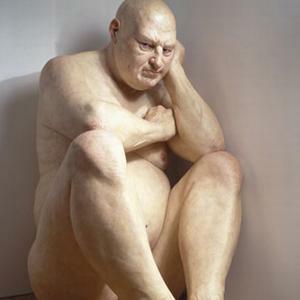
Even if you're trim and fit, the more you sit, the sooner you may die.
Mobility is a classic hallmark of being an animal, as opposed to being, say, a bread mould. (The demotion to the vegetable realm implied by “couch potato” is very apt.)
Sessile creatures, those fixed in place like barnacles and sea sponges, are confined to aquatic environments where the water can buoy them up and float food within easy reach.I can't think of any examples on dry land, although the grotesquely swollen termite queen, trapped in her royal cell, comes close. As does, for extended periods on gaming chairs* and office swivels throughout the modern world, the 21st-century human.
“Sit still!” is a universal bane of childhood (along with “Sit up”, “Sit down” and “Sit quietly”), but somewhere on the way to adulthood we stop resisting this command. Whether working (scowling at screens), relaxing (hypnotised by screens), eating (frequently while hypnotized by screens) or shuttling between these activities (scowling again, through windscreens) we spend a large chunk of our lives seated.
Which is a shameful waste of the largest, most powerful muscle in the body. The reason humans have such splendidly rounded posteriors compared with other primates, has far more to do with a gluteus maximus muscle uniquely evolved to support bipedalism, and the sprinting, jumping and squatting that's supposed to go along with that, than it has to do with sitting.

Nineteenth-century human motion studies (Eadward Muybridge)
Hunter-gatherers, which is what we're still physically evolved to be, used the 8 or so hours a day we now spend seated for pottering about (gathering), putting on the occasional spurt of speed (hunting, or being hunted), and other clean-living activities like walking long distances, or dancing.

Death by chair
Sitting may sound mundane and harmless, but our excessive fondness for it is driving a major public health disaster.
Immobility, and its evil twin, overeating, are conspiring to swell the obesity epidemic and massively push up rates of chronic conditions, including cardiovascular disease, diabetes, osteoporosis, arthritis, cancer and cognitive disorders.But even if you aren't overweight, and, more surprisingly, even if you get regular exercise, prolonged sitting still puts your health at risk. Two compelling aspects of this that certainly help get me to my feet:
- The longer you sit, the shorter you live. Strange things start happening in the body if it's made to sit for hours. For instance, sugars and fats aren't removed fast enough from the blood, raising risk for diabetes and arteriosclerosis. A recent Canadian study found that mortality risk was 1.54 times higher for people who sat almost all day compared to those who spent hardly any time sitting. An Australian study showed that, compared with people who spent under 2 hours sitting watching TV daily, those who spent over 4 hours had an 80% increased risk of death from heart disease. For every extra hour spent sitting, chances of dying during the study period rose 11 percent.

- Sitting squashes and starves your spine. Bones aren't dry and static like an anatomy class skeleton: the vertebrae and their cushioning discs form a lithe, living “S” that needs frequent movement to ease weight-bearing stress from that oversized human cranium compressing it at one end and an often oversized midriff pulling it out of alignment and further compressing it at the other. Movement and position changes allow the long-suffering discs to alternately fill with fluid and nutrients, and then flatten to squeeze out waste products – they don't have their own blood vessels to do this for them; they need your help.
I had plenty of time and opportunity, as well as a nagging lower thoracic disc injury, to brood on sedentary ills during a recent gathering in London of my far-flung extended family.
It's an enduring myth that staying with people you know while on holiday cuts costs and stress levels. Half the clan were lodged in Notting Hill (West End, where you might be unlucky enough to bump into Hugh Grant), the rest in Walthamstowe (East End, round the corner from the Liquid bomb plotters). This meant an unnatural amount of time down the always aptly named Tube every day for the East Enders, who didn't include anyone over 75 or under 5 and thus bore the brunt of the commute.
We know public transport is better for the planet than private motor vehicles, but extended periods in the cramped heat of the Old Smoke's nether regions aren't healthy on the personal scale. You burn a couple of kilojoules walking between Tube stops, but not enough to count as a decent workout by hunter-gatherer standards.
And then there's the interminable sitting, which is at a premium Underground. The morose Standing do so only until the Sitting vacate a space, and then they rush it, the pregnant or elderly be damned.
Like it or not (and I didn't), unwholesome or just plain dull urban settings are where most of us will spend a sizeable portion of our lives, so we may as well maximise the time we're stuck there. With a little imagination, even the grimmest metropolis holds a jungle-gym of possibilities.
Parkour, lite
The pioneers of human body movement in urban space are traceurs, practitioners of parkour, the heart-stopping sport of rapid self-propulsion (they call it “flow”) round, over and through obstacles presented by the built environment, using their bodies like animated grafitti art to transform it.

Traceur performing a "cat balance" (Jon Lucas)
Unfortunately, for most of us past the age of about 23 (and a supple 23 at that), even the humblest parkour manoeuvre would probably be our last.
But there's scope for developing a gentler version: where a traceur would vault an iron railing, for example, I might climb over it. Less flowing perhaps, but still more interesting than using the designated entrance.
It's not just because we're past the lissom age that we feel this sort of physical whimsy is denied us. Maturer adults are frowned on if they aren't sufficiently sedate. Where a 19-year-old can get away with swinging from the overhead railing in the Tube, someone a mere two or three decades older (and who should be quite capable of this move, if perhaps a subtler version of it), is considered downright unseemly, and, if female, unladylike.
What the 35-plus crowd do have over those who've clocked only a paltry number of years, is that we no longer believe we're immortal, and therefore care a lot less about looking like an idiot and a lot more about savouring the dwindling moments we have left.
But if your inhibitions are still holding you back, then I would strongly recommend procuring a child.
Climbing lamp-posts and trees while wearing a gold party-hat are not normally performed sober in broad daylight, but I managed them in Kensington Gardens without a single curious glance or shred of embarrassment. This was because my three-my-old nephew was at my side, egging on me on to ever more ludicrous feats for his entertainment. Children are permitted to act like the joyful psychotics they are in public, and you can use them as a cover to do the same.

Taking the load off
Obviously we can't keep skittering around town like jumping jacks non-stop. We have to rest periodically too, but when we do we should be reclining wherever possible, not sitting. Staying in any position for too long is bad, whether standing, sitting or lying down. But reclining reduces the pressure placed on your back by 50-80%, whereas unsupported sitting increases pressure by 40%.
Lying down, like exuberant movement, is tricky in public too; it's seen as sort of untidy and spatially inefficient, and has connotations with sloth. Not to mention sex. Lying prone or supine makes you look and feel either vulnerable, or vaguely suggestive. Lying on your side, in imitation of the recovery position, is more acceptable, especially if you adopt a pained expression.
When you have to sit, it's also better to sit partially-reclined. The latest studies measuring spinal disc pressure found that the sit-up-straight 90° angle we've been taught as virtuous in fact puts more pressure on the spine than leaning back (supported) at 120°-135°. Sitting forward at about 70° measured the greatest strain on the spine.

Don't hold that pose: an acute angle stresses the spine. (The Thinker, Rodin)
Break it up
Some medical experts are suggesting a spaced-out working day: 45-minute stints interrupted by short intense bursts of exercise, rather than the current 9-to-5 sedentary time slab followed by an hour or so of exercise.
I have happy visions of the entire 24.com office united in a Mexican wave every 15 minutes, although I may need to work on my powers of persuasion before that happens. But change is possible: thanks to the media's relish of deep vein thrombosis stories, we've absorbed the message that sitting on long-haul flights is risky, and it's now common to see people getting up to do funny bends and stretches.
The more we move, the less odd it’ll seem. It’s how Homo Sapiens went about things for 5 million years, after all. I’m sure it’ll come back to us. So, altogether now please: stand, stretch, and step away from the screen…
- Olivia Rose-Innes, EnviroHealth Editor

Footnote: *A “gaming chair”, or “gaming pod”, is designed for sitting in while playing computer games. The idea is to enhance the virtual experience (games typically involve fast-paced action, ironically) and shut out any distractions from the real world. Pods range from home-made efforts where gamers get into a cupboard with their computer and chair, and shut the door (really), to sleek hi-tech wrap-around jobs that “totally immerse” the player in the game. Most require you to sit back, which is at least kinder on the back than hunching forward. On the other hand that means greater comfort, encouraging game-time marathons. Pods are popular with kids and teenagers, and are doing much to facilitate the upcoming generation's ruinous transition to a sedentary lifestyle.

References
Bouchard, C et al (2009) Sitting time and mortality from all causes, cardiovascular disease, and cancer.
Dunstan, D. et al (2009) Television Viewing Time and Mortality. Circulation
Jouffroy, F and Medina, M. (2006) A hallmark of humankind: the gluteus maximus muscle. Its form, action and function. Human origins and environmental backgrounds. Ishida, H (Ed)
Matthews, C.E. Et al. (2008) Amount of Time Spent in Sedentary Behaviors in the United -States, 2003–2004 American Journal of Epidemiology, February 2008




 Publications
Publications
 Partners
Partners













